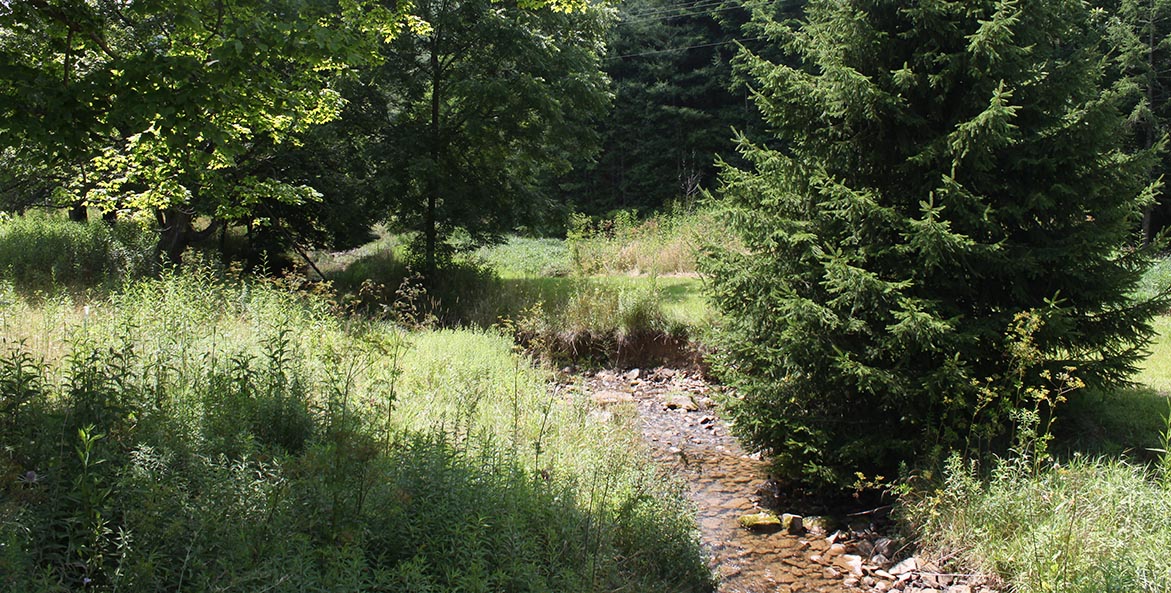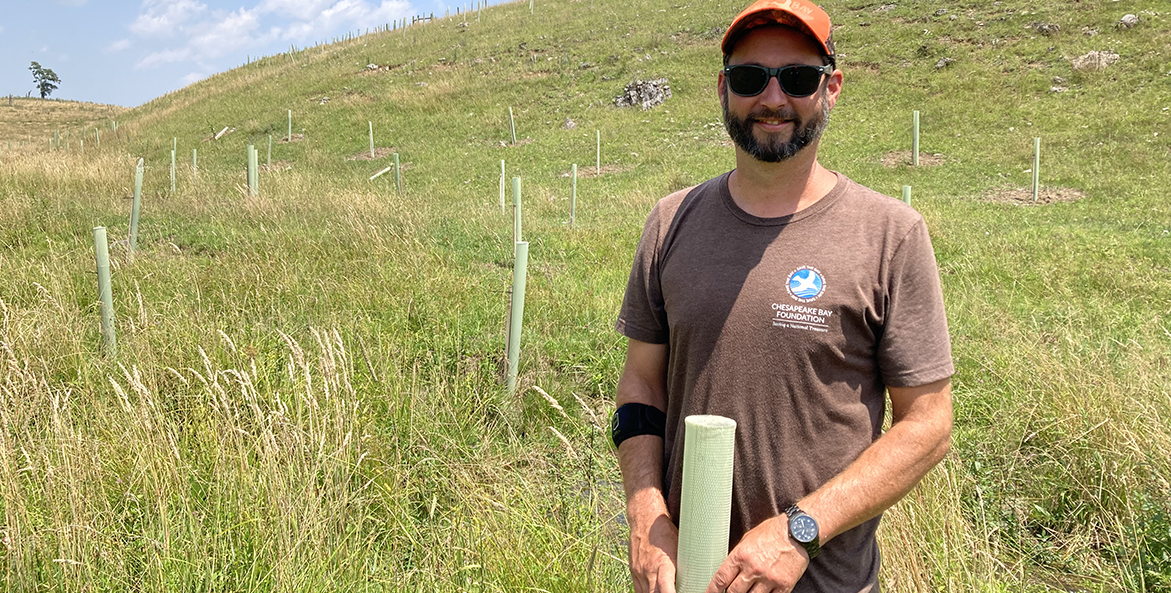This was originally published as an opinion piece in Agri-Pulse on October 18, 2023.
If someone offered to design, install, and take care of a streamside buffer on your property for free, would you take them up on it?
They would supply the capital, the materials, the know-how, and the labor—all at no cost to you. You could decide which native trees and shrubs, and how many of them, to plant next to your stream, with no limit on the width of the buffer. They would also maintain the buffer, including replacing seedlings that don’t survive, for the all-important first three years.
It would only take a few minutes to apply and any interested landowner would be eligible.
This flexible, no-hassle program really does exist. I know how popular it is with landowners because I have worked with several people over the last few years to plant trees through it.
It’s called the James River Buffer Program and it is administered by the nonprofit James River Association, the Virginia Department of Forestry, and the Chesapeake Bay Foundation (CBF). Other partners include the Virginia Soil and Water Conservation Districts, the Natural Resources Conservation Service (NRCS), the Virginia Outdoors Foundation, Trout Unlimited, and the National Fish and Wildlife Foundation. Funding is provided by the Virginia Environmental Endowment, a private grant-making organization.
After just four years, the program is already responsible for planting more than 900 acres of forested buffers on several dozen properties in the Middle and Upper James River watershed in Virginia. CBF alone has another 15 properties currently awaiting site visits or buffer plans. Partners estimate that we have used the program to install more than half of all buffers planted in the James River watershed, far outpacing state and federal programs.
The next Farm Bill could support a similar program that would provide big benefits for both farmers and the health of local waterways.
That’s important because installing new streamside buffers is one of the Bay states’ main strategies to meet their commitments to reduce excess nitrogen, phosphorus, and sediment running off farmland into the Bay and its tributaries. While existing state and federal programs offer funding to landowners to plant buffers, they do not provide the same combination of full funding, maintenance, and technical assistance that has made the James River effort so successful.

Forested buffers along streams like this headwater stream of the Jackson River, located on Glen Valley Farm, provide habitat for pollinators, birds, and other wildlife. They also create shade to keep both the stream cool for fish like trout and livestock cool, while preventing the animals from eroding stream banks and polluting the water.
Codi Yeager/CBF Staff
Buffers naturally filter and absorb pollutants before they can reach local waterways that feed the Bay. Buffers also mitigate flooding, sequester carbon, and reduce water temperatures — valuable benefits as we confront increasing episodes of extreme weather exacerbated by climate change. Forested buffers even make it possible for the streams to clean themselves by removing nutrients in the water through natural processes.
Buffers are incredibly cost-effective, too, maximizing your return on the state and federal conservation dollars you invest. How much would you rather spend to reduce a pound of nitrogen runoff, $7.62 on buffers or $2,350 on a manure management system? Plus, the conservation benefits last a lot longer than practices that have to be repeated every year, like planting cover crops.
Unfortunately, Virginia and the other four Bay states are only installing an average of 25 percent of the 38,000-acre annual target they set for themselves, according to data from the federal Chesapeake Bay Program, which oversees the multiagency federal-state restoration partnership.
Farmers can play a crucial role in turning things around by planting forested buffers to reduce runoff. The 2023 Farm Bill can support them by creating an initiative like the James River program for the entire 64,000-square-mile Bay watershed.
Farmers know forested buffers offer many benefits to their operations as well as to the Bay and its local rivers and streams. Buffers provide habitat for pollinators, birds, and other wildlife. They also create shade to keep livestock cool while preventing the animals from eroding stream banks and polluting the water.
But designing and installing a buffer is an expensive, time-consuming proposition. Most farmers want to be good stewards of the land. The James River Buffer Program makes it easy for them to do so.
Once farmers learn the program covers 100% of the costs up front and literally does all the dirty work, they’re all in. Dizzy Garten, owner of Glen Valley Farms in Covington, Virginia, sure was.
CBF is partnering with Trout Unlimited, the Mountain Soil and Water Conservation District, and the NRCS on Dizzy’s land, which is home to the headwaters of both the Jackson River (a tributary of the James) and the South Branch of the Potomac.
CBF will ultimately plant between 50 to 60 acres of forested buffers and Trout Unlimited will put up several miles of fencing, plus install tire troughs as an alternative water source. Together the trees and fencing will keep Dizzy’s cattle out of waters that are cold enough to support trout. Shade from the trees will also help keep the water cool.
Sugar maples are in the mix, so Dizzy eventually will be able to produce maple syrup as well.
Instead of Dizzy having to front thousands of dollars and wait to get reimbursed for 80 percent of his costs and spend his time finding contractors to do the work, the James River Buffer Program is taking care of everything. Plus, he’s getting new revenue sources in the bargain.
A watershed-wide buffer planting program could cover all costs if it were created within the Conservation Reserve Enhancement Program (CREP). Landowners would assign the federal and state cost-share and the signing and practice incentive payments to the contractors doing the work. But the landowner would still receive the annual CREP rental payments for acres that are planted through the program. No new money would be needed because CREP already covers these costs for buffers.
Congress can use the next Farm Bill to support farmers who are helping ensure a healthy, productive Bay and tributaries for future generations while helping Bay states fulfill their commitments to plant buffers to reduce pollution. I urge lawmakers to seize this opportunity while there is still time to make a difference.
About the author: Alston Horn is the Chesapeake Bay Foundation’s Virginia Restoration Specialist. Alston identifies and recruits farm landowners, primarily in the Shenandoah Valley, to adopt agriculture best management practices on their land. He acts as a liaison between farmers, federal, and state staff to help farmers receive cost-share funds for best management practices. Alston also leads CBF efforts on outreach to farmers about alternative grazing management. Alston has been with CBF for 13 years.



